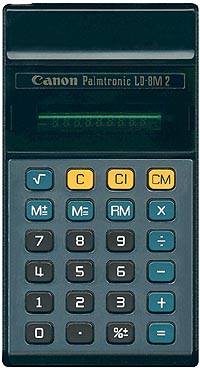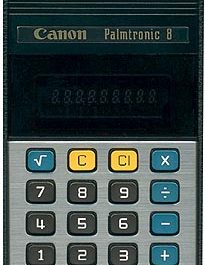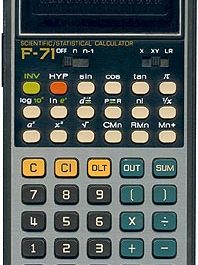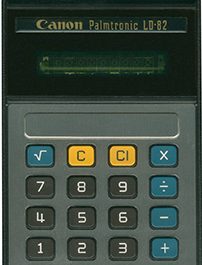
The Canon LD-8M2 is a basic handheld calculator from 1975. It measures 74mm x 130mm x 21mm and weighs 114g without batteries. The calculator is powered by two AA batteries or can be charged via an AC adapter that plugs into a socket on the top left side.
The case is made of two pieces of glossy black plastic. It has a large green plastic display filter that sits slightly raised above the rest of the case. Below this is a recess with a metallic gold Canon logo. The keyboard surround is brushed aluminum that wraps around the bottom edge. The keys are Canon’s familiar blue and yellow with a soft click and medium travel.

The display is an 8-digit green vacuum fluorescent display. It has a ninth digit used for indicating negatives, overflow, and memory usage.
The LD-8M2 has the standard four functions – addition, subtraction, multiplication and division – along with percentages, square roots, and a 4-function memory.

The calculator employs some basic logic to handle errors. Input overflow is suppressed, ignoring any input beyond 8 digits. Overflow and divide by zero errors show “E” in the leftmost digit and lock the calculator. Negative numbers are displayed with a minus sign in the leftmost digit, allowing for full 8 digit negative results. Square roots of negative numbers are not allowed and also lock the calculator. Memory usage is indicated by “II” in the leftmost digit.

Inside, the LD-8M2 uses a Hitachi HD36264 CPU and a single Futaba vacuum fluorescent display tube. The main board floats on wires soldered to the keyboard plate. There is also a secondary power supply board. It was manufactured in Japan by Canon with a 1975 date code.
The Canon LD-8M2 provides basic functionality in a compact package. While limited in features, it employs some simple logic to handle errors better than cheaper calculators of the era. The combination of Canon’s trademark styling and vacuum display make this a popular vintage calculator for collectors.


